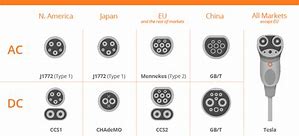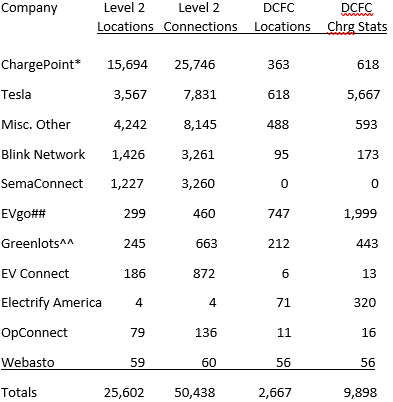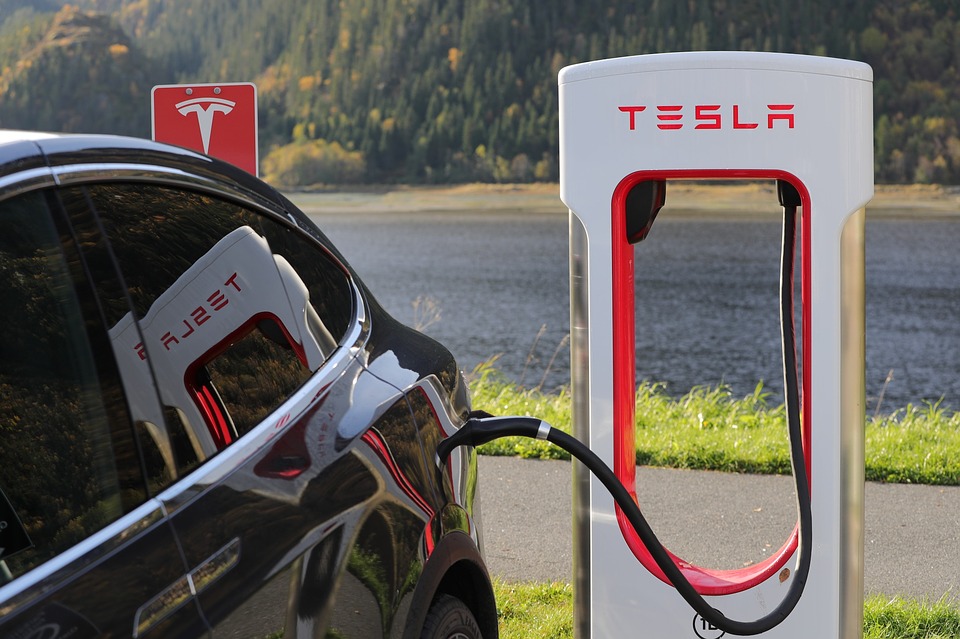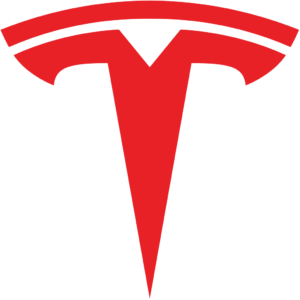In this series of seven blogs, we will cover the information you need to know about charging battery powered electric vehicles (EVs). To make the topic easier to digest, we have broken it into seven short blogs, namely:
- Part 1 – Battery and battery charging basics
- Part 2 – Battery performance measures
- Part 3 – EV battery charging – charging levels and home charging
- Part 4 – EV battery charging – outside the home; connectors and charging companies
- Part 5 – EV battery charging – problems with public charging stations; EV charging costs versus ICE-powered fueling costs
- Part 6 – Looking at EV charging’s big picture
- Part 7 – Trends in solar power that will accelerate the move to electric vehicles
Charging outside the home:
Because of differences between electric vehicle manufacturers’ specifications and the lack of countrywide or global standards, different electric vehicles and charging units require different charging cable connector plugs as well as charging power – – noted previously. In the following section, we examine the different cable connector plugs, what type of charging they support, and give some examples of popular electric vehicles that use them.
Referring to the illustrations below:

Tesla:
The Tesla plug on the right is the standard Tesla five-pin charging plug that is used across all US Tesla vehicles and can be used with all levels of chargers. Tesla also provides an adapter cable with all their models that enables their vehicles to use a J1772 charging cable.
Incidentally, currently only Tesla vehicles can utilize their Supercharger stations. It is not possible to use a plug adapter to use a Supercharger, as Tesla has an electronic validation process to ascertain that you are charging a Tesla.
Since October 16, 2017, Tesla Model S and Xs for the China market are coming with two charging ports – one for the standard Tesla plug and one for the CHAdeMO plug used by some charging station companies. This opens up more charging possibilities (albeit at greater cost!) for Chinese Tesla owners, particularly when on long-distance trips.
Teslas sold in international markets come with the charger port that is standard or required or sometimes most popular in the market country.
AC plugs: (Level 1 and 2 charging)
The US and Japan use a SAE J1772 5 pin plug (Type 1 – the “J” plug), the two illustrations on the top (AC) left and center.
The European Union uses a 7 pin Mennekes Type 2 plug, third from the left in the top (AC) row.
China uses a GB/T 7 pin plug, fourth from the left in the top (AC) row.
DC plugs: (Level 3 DCFC charging)
The US uses a Combined Charging System (CCS) 1 plug with 2 large pins in one part of the plug, and 5 smaller pins in the other part, shown on the bottom (DC) left. This is the standard for DC fast charging in North America.
Japan uses a CHAdeMO 2 pin plug, shown second from the left in the bottom (DC) row. It is the standard for DC fast charging throughout Japan. In North America, only Nissan and Mitsubishi use CHAdeMO, as Kia switched to CCS in 2018.
The EU uses a CCS2 plug with 2 large pins in one part of the plug and 7 smaller pins in the other part, shown third from the left on the bottom (DC) row.
China uses a 9 pin plug – 2 large pins and 7 smaller ones, shown fourth from the left on the bottom (DC) row.
Electric vehicle owners can purchase a variety of adapter plugs and cables in the EV aftermarket that allow various combinations of charging stations’ cables/plugs to mate up with most individual electric vehicles. This greatly expands the available charging network to range-anxious or long distance drivers or electric vehicle owners that live in more rural locations. The important matter to be aware of regarding these adapters is for the vehicle owner to recognize the limits of his/her vehicle to accept a given charge rate.
Public charging companies and networks:
It is difficult to keep up with the growth and changes in the world’s public electric vehicle charging stations. New companies are emerging, and older more established companies are being bought up, notably by oil and gas companies or other late-to-the-party investors. And almost daily new entrepreneurial companies enter the fray.
Equally frustrating is the fact that it’s difficult if not impossible to sort out competing companies’ claims and figures as web sites are not always up-to-date, terms are not standardized, home charger installations are not always differentiated from public charging stations, and charging stations are often loosely described. Is a “station” one charging cable or two charging cables?
The most accurate and detailed numbers that I can find are from EVAdoption and are dated March 31, 2019. I have also checked each of the major companies listed below websites to see if they had later information. Here is the US picture as portrayed out by EVAdoption. In later blogs, I will address charging station networks in Europe, Canada, China, Japan, and other significant areas of the world.

Note: EVAdoption data sourced from: Alternative Fuels Data Center
Note: * ChargePoint took over General Electric’s charging stations in 2017
^^ Acquired by Shell Oil in 2019
## Partnering with ABB and more recently, General Motors
Obviously ChargePoint and Tesla dominate this list of major players. Between them they have 75.2%, 66.6%, 36.8%, and 63.5% of each respective category. Note how Tesla’s ratio of charging stations or connectors per location is high for Level 2 stations at 1.7 and surpasses all other players for DCFC stations at 9.2. Note also that Tesla has 57.3% of the DCFC charging station coverage.
The next blog in this series is: EV battery charging – problems with public charging stations; EV charging costs versus ICE-powered fueling costs
Your feedback in the form of comments or suggestions are welcome in the comment window. Thank you for following my blogs on this site and for participating in my blogging community.




